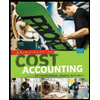
Concept explainers
Concept Introduction:
Cost Volume Profit (CVP) Analysis:
The Cost Volume Profit analysis is the analysis of the relation between cost, volume, and profit of a product. It analyzes the cost and profits at the different level of production, in order to determine the breakeven point and required the level of sales to earn the desired profit.
Contribution margin means the margin that is left with the company after recovering variable cost out of revenue earned by selling smart phones. The formula for contribution margin is as follows:
Contribution margin = Sales - Variable cost.
Similarly contribution margin ratio = Contribution/sales
Breakeven Point:
The Breakeven point is the level of sales at which the net profit is nil. It can be explained as a situation where the business is generating a sale that is equal to the expenses incurred and hence no
Weighted Average Contribution Margin:
Weighted Average Contribution Margin is calculated for two products with the help of following formula:
To Calculate:
The Breakeven point in units for each product
Trending nowThis is a popular solution!

Chapter 11 Solutions
Survey of Accounting (Accounting I)
- I need help with this financial accounting problem using proper accounting guidelines.arrow_forwardReef Corporation sells its product for $22 per unit. Next year, fixed expenses are expected to be $385,000 and variable expenses are expected to be $13 per unit. How many units must the company sell to generate a net operating income of $115,000? (Round your answer to nearest unit) Provide answerarrow_forwardI am trying to find the accurate solution to this financial accounting problem with appropriate explanations.arrow_forward
- General Accountingarrow_forwardAcme Manufacturing sold a vehicle for $12,200 that originallycost $22,000. The balance of the Accumulated Depreciation account related to this vehicle was $14,500. The entry to record the gain or loss on the disposalof this vehicle would include: a. A debit to loss in the amount of $3,500. b. A debit to loss in the amount of $6,500. c. A credit to gain in the amount of $2,800. d. A credit to gain in the amount of $4,700.arrow_forwardCan you solve this general accounting problem with appropriate steps and explanations?arrow_forward
- I am searching for the most suitable approach to this financial accounting problem with valid standards.arrow_forwardWillow Industries is evaluating its cost structure and pricing strategy. The company produces a single product that sells for $42 per unit. Variable manufacturing costs are $25 per unit, and variable selling expenses are 5% of the selling price. Annual fixed manufacturing overhead is $315,000, and fixed selling and administrative expenses are $248,000. If Willow desires a target net income of $180,000, how many units must be produced and sold? What would be the company's margin of safety in both units and dollars if it actually sold 30,000 units? Answerarrow_forwardCan you help me solve this general accounting question using valid accounting techniques?arrow_forward
- Principles of Accounting Volume 2AccountingISBN:9781947172609Author:OpenStaxPublisher:OpenStax College
 Managerial AccountingAccountingISBN:9781337912020Author:Carl Warren, Ph.d. Cma William B. TaylerPublisher:South-Western College Pub
Managerial AccountingAccountingISBN:9781337912020Author:Carl Warren, Ph.d. Cma William B. TaylerPublisher:South-Western College Pub Principles of Cost AccountingAccountingISBN:9781305087408Author:Edward J. Vanderbeck, Maria R. MitchellPublisher:Cengage Learning
Principles of Cost AccountingAccountingISBN:9781305087408Author:Edward J. Vanderbeck, Maria R. MitchellPublisher:Cengage Learning  Financial And Managerial AccountingAccountingISBN:9781337902663Author:WARREN, Carl S.Publisher:Cengage Learning,
Financial And Managerial AccountingAccountingISBN:9781337902663Author:WARREN, Carl S.Publisher:Cengage Learning, Managerial Accounting: The Cornerstone of Busines...AccountingISBN:9781337115773Author:Maryanne M. Mowen, Don R. Hansen, Dan L. HeitgerPublisher:Cengage Learning
Managerial Accounting: The Cornerstone of Busines...AccountingISBN:9781337115773Author:Maryanne M. Mowen, Don R. Hansen, Dan L. HeitgerPublisher:Cengage Learning




